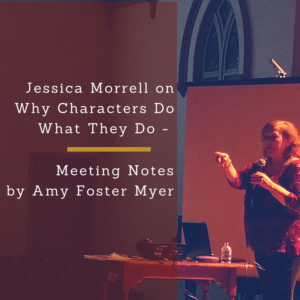This contributed piece brings notes from Willamette Writers Portland’s April 4th, 2017 Meeting with author and editor Jessica Morrell by member Amy Foster Myer. Enjoy!
 Having seen Jessica Morell present at the 2016 Willamette Writers Conference, I can tell you she is an amazing presenter who provides an absolute wealth of information in a speck of time. She is truly a gift to the writing community and an exemplar of what I believe it means to be a good literary citizen. To decide for yourself, just check out her blog. Since Jessica’s presentations are bursting with information, I will present here only the highlights from the meeting.
Having seen Jessica Morell present at the 2016 Willamette Writers Conference, I can tell you she is an amazing presenter who provides an absolute wealth of information in a speck of time. She is truly a gift to the writing community and an exemplar of what I believe it means to be a good literary citizen. To decide for yourself, just check out her blog. Since Jessica’s presentations are bursting with information, I will present here only the highlights from the meeting.
Why Is the Character in Your Story?
All characters must have a reason for being in your story. They must perform some duty to the narrative arc. Jessica shared that she so often comes across characters in her clients’ novels that seem to be running around rather aimlessly, where they either don’t have goals at all, their goals are “goofy,” or the stakes of the story don’t match the goals.
Jessica made a key point that nearly all the answers of why characters do what they do links back to structure.
It All Boils Down to Motivation
While there was quite a bit of information covered, it all boils down to this one thing: motivations – they are a must for your story to have any lift. Without a clear motivation and goal, readers don’t know what or who to root for, and if we don’t know what’s at stake, then there’s nothing at stake for us in reading it.
According to Jessica, motivations must:
- be easy to understand; not easy to achieve
- be shown in actions and move the story forward
- become more complex and personal as story progresses
- showcase the protagonist’s core traits
- reveal the protagonist’s fears
- exact a cost as the story progresses – your protagonist must always sacrifice something
- create a catharsis at the climax
We also have Levels of Motivation:
- Primary
- Secondary
- External – tangible, visible, fuels story, creates action
- Internal
- Personal
- Public
Creating Tension Through Conflict Between Internal & External Motivations
As we see with the above, each motivation must have two sides, the side that is shown to the world of the story – i.e. the other characters – and the side that is available to the protagonist and reader alone.
Clearly, quite a bit of tension can exist in the space between a protagonist’s apparent external motivators and his/her internal motivators actually are. Imagine this like a tight wire stretching between the two, your main character balancing as he/she walks back and forth. Whole novels have been built on the tension between what a character says they want, and what they actually want.
Read More
Click here to read the full meeting recap including links to 2016 conference notes as well as details on the questions we should all be asking about our characters to ensure that each character in our novel (yup, I said “each”) has a believable and intrinsic set of motivations and goals.
Please visit Jessica’s website and specifically, this post where Jessica discusses the meeting. Jessica’s site is well worth a visit on a regular basis and she also intends to post more of the material from her Willamette Writers lecture on her site in the coming weeks.
For more on structure, visit Amy’s website: Willamette Writers’ Conference – Day 2 and Willamette Writers’ Conference – Day 3 to read what Larry Brooks and Eric Witchey both have to say about structure and its importance in our novels – also amazing literary citizens.
Thank You
Thank you, Jessica, for the talk, and thank you Amy, for another meeting recap. If you like what you read, share it, thank Amy and Jessica, and join us at another monthly meeting.
